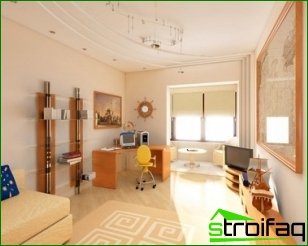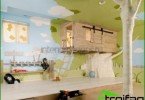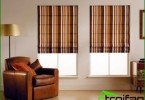Everything should be beautiful in the design of the room: floor, walls, ceiling, window, doors, etc. And the success of all the design work or frequent mistakes in design depends on what materials will be used for the manufacture of various interior elements. It should be noted that in the building materials market you can find an unimaginable variety of various decorative finishes. let’s consider types of flooring materials, that can be used in the interior of an apartment or house, this will help you learn how to decorate a room with your own hands.
Today, there are three varieties of materials for flooring: tile, roll and piece. Each species has its own characteristics, advantages and disadvantages. After reviewing them, you can choose the floor covering that will best suit your requirements.
Tiled flooring materials
Probably, everyone knows porcelain, ceramic and tile, which relate to tile materials. At their core, they are substitutes for natural stone, although you should not lose sight of the fact that there are varieties of tiles that mimic leather and wood.
The tile is durable and high strength, moreover, it has high moisture resistance. That is why it is preferred to use it in rooms with a high level of humidity and places in which there is a strong mechanical effect on the floors..
Porcelain tile has the advantages of natural stone and ceramics. Its main characteristics are low water absorption and high hardness. For its manufacture, coloring pigments, the smallest pieces of rock and a binder are used. The most widespread are tiles with dimensions of 30×30 cm and a thickness of 8-14 mm in typical floor plans.
Features of roll materials
Roll materials for the floor are cork coverings, carpet and linoleum. Their main advantages are ease of installation, low cost and the ability to replace. But they are not without drawbacks: they are easily ignited, and chemically harmful compounds are also present in their composition.
Everything should be beautiful in the design of the room: floor, walls, ceiling, window, doors, etc. And the success of all the design work or frequent mistakes in design depends on what materials will be used for the manufacture of various interior elements. It should be noted that in the building materials market you can find an unimaginable variety of various decorative finishes. let’s consider types of flooring materials, that can be used in the interior of an apartment or house, this will help you learn how to decorate a room with your own hands.Today, there are three varieties of materials for flooring: tile, roll and piece. Each species has its own characteristics, advantages and disadvantages. After reviewing them, you can choose the floor covering that will best suit your requirements.
Tiled flooring materials
Probably, everyone knows porcelain, ceramic and tile, which relate to tile materials. At their core, they are substitutes for natural stone, although you should not lose sight of the fact that there are varieties of tiles that mimic leather and wood.
The tile is durable and high strength, moreover, it has high moisture resistance. That is why it is preferred to use it in rooms with a high level of humidity and places in which there is a strong mechanical effect on the floors..
Porcelain tile has the advantages of natural stone and ceramics. Its main characteristics are low water absorption and high hardness. For its manufacture, coloring pigments, the smallest pieces of rock and a binder are used. The most widespread are tiles with dimensions of 30×30 cm and a thickness of 8-14 mm in typical floor plans.
Features of roll materials
Roll materials for the floor are cork coverings, carpet and linoleum. Their main advantages are ease of installation, low cost and the ability to replace. But they are not without drawbacks: they are easily ignited, and chemically harmful compounds are also present in their composition.
For the production of cork types of materials for the floor cork oak bark is used. Cork grains are glued at high temperatures with a special glue. The result is sheets that are cut into slabs or rolls of the desired shape. After that, they are rubbed with a hot mixture of paraffin and beeswax. Cork materials are durable and environmentally friendly, in addition, they have good heat and sound insulation characteristics, as well as excellent decorative texture. Their main disadvantage is the high cost..
The benefits of decking
From dense wood species, which is resistant to rot, a terrace board is made. It is most often used for flooring pools, terraces and gazebos. Usually exotic trees of high cost are used for its manufacture. Moreover, in terms of life, it is not inferior to ceramic tiles. The most affordable option is a terrace board made of larch. It should be noted that a terrace board is made specifically for outdoor floors. Its main difference from a typical board is an external corrugated plane, which prevents slipping. There are wide grooves on the back of the decking board that are made to compensate for changes in humidity and internal stresses..
Not so long ago types of flooring materials the terrace board was replenished with a composite, created from a wood-polymer composite. It is a hollow extruded profiles, which include a binder, wood flour, dyes and modifying additives. Composite decking has the color of the whole mass, which allows it to simulate valuable tree species. It is characterized by durability, strength, in addition, it is protected from rot and moisture, the board does not fade in sunlight.
Piece materials for flooring
Piece materials are most often a kind of wooden floor. These include parquet (typesetted and piece), floor and parquet boards, panels and laminate. Laminate is a material imitating natural wood. Its wide popularity is mainly due to its low price. In its structure, it resembles fiberboard: individual boards are made from extruded laminated plastic, which are then laminated using decorative wear-resistant films. The texture of the coating depends on the picture of the film – whether it is a stone or a tree. Its main disadvantage is poor resistance to shock, especially to falling objects with sharp corners.
As you can see among all the materials for the floor there are more and less quality ones. As a rule, high quality natural materials are more expensive. But if you have the opportunity to purchase them, use it. If not, then consider options for other coatings. A wide range of materials for the floor will allow everyone to choose the right product for the interior design of the room.







